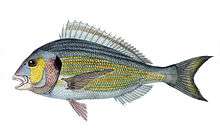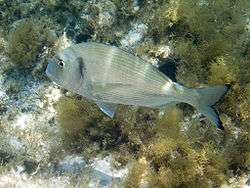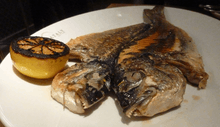Gilt-head bream
| Gilt-head bream | |
|---|---|
 | |
| Sparus aurata | |
 | |
| Scientific classification | |
| Kingdom: | Animalia |
| Phylum: | Chordata |
| Class: | Actinopterygii |
| Order: | Perciformes |
| Family: | Sparidae |
| Genus: | Sparus Linnaeus, 1758 |
| Species: | S. aurata |
| Binomial name | |
| Sparus aurata Linnaeus, 1758 | |
 | |
| Sparus aurata - Distribution map | |
The gilt-head (sea) bream (Sparus aurata) is a fish of the bream family Sparidae found in the Mediterranean Sea and the eastern coastal regions of the North Atlantic Ocean. It commonly reaches about 35 centimetres (1.15 ft) in length, but may reach 70 cm (2.3 ft) and weigh up to about 7.36 kilograms (16.2 lb).[2]
The gilt-head bream is generally considered the best-tasting of the breams. It is the single species of the genus Sparus – the Latin name for this fish[3] – which has given the whole family of Sparidae its name. Its specific name, aurata, derives from the gold bar marking between its eyes.
Biology

It is typically found at depths of 0–30 metres (0–98 ft), but may occur up to 150 m (490 ft),[2] seen singly or in small groups near seagrass or over sandy bottoms, but sometimes in estuaries during the spring.[2]
It mainly feeds on shellfish, but also some plant material.[2]
Fisheries and aquaculture
Gilthead seabream is an esteemed food fish, but catches of wild fish have been relatively modest, between 6,100 and 9,600 tonnes in 2000–2009, primarily from the Mediterranean.[4] In addition, gilthead seabream have traditionally been cultured extensively in coastal lagoons and saltwater ponds. However, intensive rearing systems were developed during the 1980s, and gilthead seabream has become an important aquaculture species, primarily in the Mediterranean area. Reported production was negligible until the late 1980s, but reached 140,000 tonnes in 2010, thus dwarfing the capture fisheries production.[5] Greece is the biggest seabream producer in Europe, followed by Turkey.[6]
Cuisine

.jpg)
The fish is widely used in Mediterranean cooking, under a variety of names:
- In Albania it is called koce.
- In Bulgaria it is called tsipúra, (ципура).
- In Catalonia the fish is referred to as orada or daurada.
- In Croatia it is called ovrata, orada, lovrata or komarča.
- In Egypt it is called denees.
- In Estonia it is called kuldmerikoger.
- In France it is called daurade (or dorade) royale.
- In Germany the fish is called Goldbrasse or Dorade.
- In Greece and Cyprus it is called tsipoúra (τσιπούρα).
- In Ireland it is known as a Gilthead and found mostly in the south west, especially in Cork Harbour.
- In Israel and the Palestinian Territories it is known as chipura (from the Turkish "çipura") or denees in both Hebrew and Arabic.
- In Italy, the fish is called orata.
- In Lebanon and Syria it is Called Ajaj
- In Malta it is called awrata.
- In the Netherlands it is called Goudbrasem or Dorade.
- In Portugal and Galicia the fish is referred to as Orata or Dourada (golden in Portuguese and Galician; a name also used for other species, e.g. Brachyplatystoma rousseauxii), and is widely available as a fresh fish meal in local restaurants in the Algarve and along coastal Portugal.
- In Romania it is called doradǎ.
- In Serbia it is orada.
- In Spain it is called the dorada. It is also highly prized and is both commercially fished and raised in fish farms. In Cadiz Atlantic coast is called Zapatilla, in Barbate the largest specimens are called Murcielago (bat), in Chipiona are called Chapaneta[7]
- In Slovenia, the fish is called orada.
- Ιn Turkey the fish is referred to as çipura or çupra.
- Ιn Tunisia and Libya it is called wourata.
- In Ukraine it is called spar (спар), also dorada (дорада) or dorado (дорадо).
- In Morocco it is called Haksa, also daurade.
- In Macedonia it is called "orada" (орада).
References
- ↑ NatureServe (2013). "Sparus aurata". IUCN Red List of Threatened Species. Version 2014.3. International Union for Conservation of Nature. Retrieved 15 December 2014.
- 1 2 3 4 Froese, Rainer and Pauly, Daniel, eds. (2010). "Sparus aurata" in FishBase. October 2010 version.
- ↑ sparus. Charlton T. Lewis; Charles Short. A Latin Dictionary. Perseus Project.
- ↑ FAO (Food and Agriculture Organization of the United Nations) (2011). Yearbook of fishery and aquaculture statistics 2009. Capture production (PDF). Rome: FAO. p. 163.
- ↑ "Sparus aurata (Linnaeus, 1758)". Cultured Aquatic Species Information Programme. FAO Fisheries and Aquaculture Department. Retrieved 22 September 2012.
- ↑ http://www.fao.org/fishery/countrysector/naso_greece/en
- ↑ Ministerio de economía y competitividad (spanish government). "Sparus aurata". www.ictioterm.es.
- Alan Davidson, Mediterranean Seafood, Penguin, 1972. ISBN 0-14-046174-4, pp. 86–108.
External links
-
 Media related to Sparus aurata at Wikimedia Commons
Media related to Sparus aurata at Wikimedia Commons - a review of most updated knowledge about gilthead seabream from the AQUATRACE EU Project


.png)
